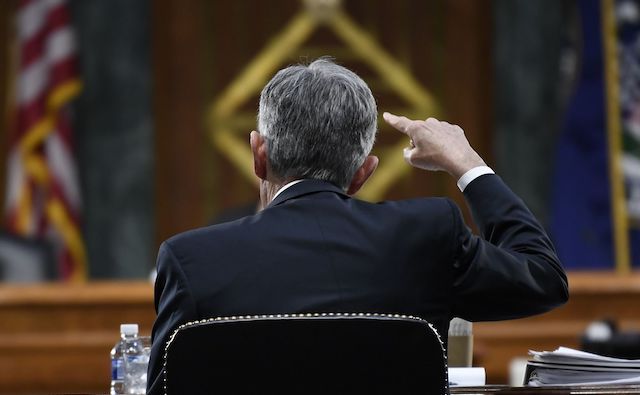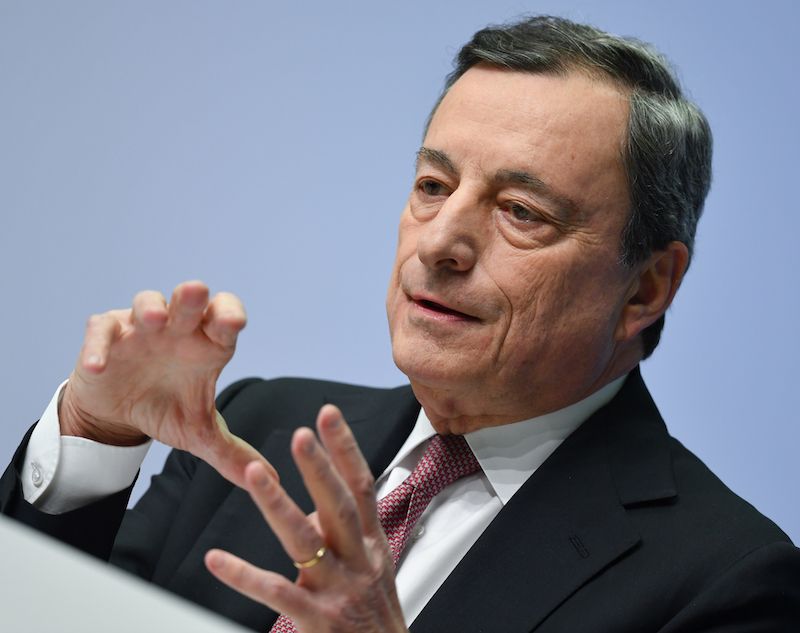Which Fed monetary policy ‘normalization?’
Should policies centered on more broadly defined money supply replace traditional preoccupation with interest and inflation rates? Is there a way to tame overregulation in the financial sector while making it more stable and more squarely based on entrepreneurial responsibility?

In a nutshell
- Monetarists see weak growth in the last decade as caused by insufficient money supply growth, despite QE and low interest rates
- Overly restrictive, top-down regulation is seen as a reason for this insufficient money supply growth: banks need more freedom to respond to market needs
- Deregulation is not enough; new rules are needed, based on restoring entrepreneurial responsibility in the banking sector
The “normalization” of monetary policy in the United States, which started with the first interest rate hike in December 2015, is in standby mode now. The unwinding of the Federal Reserve’s balance sheet after its formidable expansion since the 2008 crisis has been slowed down and interest rate hikes have been stalled. Fed Chairman Jerome Powell talks of a “patient” approach.
To many market-watchers, this could be a sign that the Fed does not even know what it is doing (as critics frequently charge). They are impatient to see a return to the clear rules that underpin long-term credibility and stability. For some monetarist economists, the focus on interest rates, rather than money supply and the negative impact of new banking regulations, unduly complicates things. Such economists see the policy normalization process as an opportunity for a paradigm shift toward better monetary and banking governance.
Follow the money
For monetarists, money is at the heart of economic dynamics. In that respect, monetary (money supply) policy takes precedence over fiscal (government spending and taxation) policy. The target is monetary stability. To some extent, monetarists oppose both free-market economists who insist on money “soundness” (rather than stability) and interventionist economists who do not mind an expansionary, inflationary monetary course. A monetarist criticism of the Fed’s monetary policy for the past three decades is that it had often been too loose, creating speculative bubbles and then too tight – constraining growth or recovery.
Today, some monetarists tend to use the broadest possible concept of money supply.
To prevent inflation, monetary policy should ensure that the growth of money supply in the economy is not too high compared to trend economic growth (which is different from inflation-targeting). To avoid recession, the money supply should not lag behind nominal gross domestic product (GDP) growth. The favored monetarist focus is thus money supply, rather than (actual or expected) interest rates and inflation rates. A monetarist economist such as Professor Steve Hanke links nominal GDP growth and aggregate demand growth to money supply expansion.
But which money supply? Traditional, narrow measures of monetary aggregates (M2), often used by central banks, might be leaving some money out. Today, some monetarists tend to use the broadest possible concept of money supply, which includes “quasi-money.” To make the measure as accurate as possible, quasi-money instruments are not given the same degree of “moneyness” but are weighted – less than notes or coins, for example, in the measure of money. The recent “Divisia M4” aggregate, based on such a method of not “simple-sum additions” is the monetarists’ preferred tool. It includes weighted measures of money-market funds, long-term deposits, commercial paper, repurchase agreements (repos), and Treasury bills.
Private and state money
This monetarist perspective has interesting consequences, notably when trying to understand the post-2008 crisis period. Indeed, other free-market economists feared depressed interest rates and Quantitative Easing (QE) policies would unleash inflation in the U.S. and Europe.
Regarding QE, the monetarist camp pointed out that central bank money is but a tiny fraction of money creation, the biggest chunk (between 70 and 90 percent depending on countries) of which comes from private banks (through credit) and non-bank private actors (through “repos,” commercial paper, etc.). During the economic slump, private money creation collapsed and QE monetary policies actually less than offset the fall – at least within the U.S.
Of course, QE also came with problems such as regime uncertainty and what Professor Larry White calls “preferential credit allocation,” susceptible not only to a simple lack of efficiency through credit misallocation, but also lobbying and cronyism.
Overall, the growth of money supply (state plus bank money) was low, despite QE – especially in 2010-12 and 2014-2016 for the U.S. Hence, there was sluggish economic growth due to a form of “credit crunch.” It was only between 2016 and mid-2018 that broad money supply in the U.S. finally fell in line with long-term economic growth, potentially explaining the country’s strong economic growth in 2018. For most of the postcrisis period, however, the monetary stance had been, according to monetarists, restrictive. How could this be?
Regulation and QE vs. recovery
Obviously, the 2008 crisis had a depressing effect on private money creation, as it brought fear and lack of confidence among economic actors. Less intuitively, though, zero-rate monetary policies themselves created a “zero-interest trap” – by shrinking banks’ incentives to lend to one another on the interbank market – and compressed banks’ profit margins. Interest paid on excess reserves at the Fed (to contain inflationary pressure) also contributed to a fall in the bank money supply. Worse still, this situation was compounded by stricter bank regulations that were supposed to improve the financial system. In 2010, Basel III banking regulations internationally and Dodd-Frank legislation in the U.S. had a tightening effect on private money. Banks’ ability to lend was constrained with toughened capital-asset requirement standards.
The unintended consequence of the stricter rules is their pro-cyclical effect on the economy.
French economist Henri Lepage recently took the analysis further, beyond national boundaries. Since the 2000s, he argues, globalization has developed its own global wholesale money market, which uses safe assets (notably government bonds of developed countries) to securitize contracts. This translated into the production of “global money” (offshore dollars) – which is hard to track given the scarcity of statistics. New regulations and QE have had a negative impact on global money. QE absorbed vast quantities of safe assets, making them scarcer and increasing their price (and thus decreasing their rates). Global money thus decreased.

Price increases in safe assets (for collateral) add to the increased costs for banks and financial institutions. And new U.S. regulations to integrate global repo operations in capital-asset ratios and liquidity ratios of the few global “market makers” have given them the incentive to rein in their activities. As a result, the global money market is dysfunctional, which is not good news for growth.
The unintended consequence of the stricter rules is their pro-cyclical effect on the economy. For banks and non-bank actors, all this amounts to tight monetary policy. In the context of attempts to normalize monetary policy, especially the prospect of unwinding the Fed’s enormous balance sheet, a monetarist goal would be to ensure that private money can finally regain its place and compensate for the reduction in “state money.”
Such a process would require a serious paradigm shift. Banks need more freedom to respond to market needs. The current regulatory framework is too constraining.
Which ‘regulation?’
This raises the question of regulation. The banking system was already highly regulated from the top down before 2008. The first problem was that enforcing the regulations partly relied on experts from the banking profession – the regulators could be “captured” by the regulated. Then, because the regulations were so complex, banks would work around the spirit of the rules while respecting their letter. Third, the multiplicity of agencies created an incentive for banks to engage in regulatory arbitrage. Fourth, several government policies related to expanding home ownership (the American Dream Downpayment Assistance Act, the Community Reinvestment Act, the social-engineering missions of Fannie Mae and Freddie Mac) badly skewed the incentives of the entire system.
Another set of concerns relates to the new regulatory framework consisting of thousands of pages of rules: it is costlier but still shaky. Among the newly instituted rules are higher capital-asset ratios (Basel III). Beyond raising costs, these regulations imply that regulators know better than bankers how to assess risk (thanks to complicated formulas) and that capital-asset ratios should be the same for everyone. The so-called Volcker Rule, which aims to separate “speculative activities” from traditional banking operations, leaves unclear which activities exactly are “speculative.”
Criticism of the current regulatory framework does not mean a plea for an absence of regulation.
Just as with the idea of breaking up big banks in the aftermath of the 2008 crisis (who knows what the right size is?), the “pretense of knowledge” in regulation is pervasive. Understanding incentives in the process matters, too: to paraphrase Bismarck, regulations are like sausages, you don’t want to know how they are made (compromise, lobbying, etc.). That is why it is hard to be sure that implicit bailout guarantees for the too-big-to-fail financial institutions truly disappeared, for example.
The current not-so-improved system still faces both incentives and knowledge issues. Yet criticism of the current regulatory framework does not mean a plea for an absence of regulation. Good rulemaking for financial systems enhances their durability and resilience. These days, however, “regulation” usually means the government’s exogenous, top-down interventions. There is, however, another type of regulation, endogenous, or from within. In a market system, such regulation is based on entrepreneurial responsibility. That means banking entrepreneurs should know their risks. But when a regulator decides for a banker, the latter’s responsibility vanishes. The same occurs when politicians decide for bankers. Or, when profits are privatized but losses are paid for by a check from the taxpayer. When the incentives are not right, the compass of market discipline is broken.
Possible paths
Ideally, institutional improvements should maximize bankers’ and bank shareholders’ skin in the game – for good, responsible governance. A return to a genuinely entrepreneurial, capitalist banking structure is therefore required to strengthen the system and make sure it can absorb or avoid shocks from black swan events – to use Nicholas Nassim Taleb’s famous concept. The question now is: What are the chances of this happening? The 2008 financial crisis and moral panic that followed it provided a fabulous opportunity for the regulatory bureaucracy to expand; it will be hard to shrink it now.
There have been recent deregulation attempts in the U.S., of course. The problem with top-down deregulation, though, is that it should not only aim to reduce the regulatory burden for economic reasons but focus first on maximizing responsibility, which has not always been the case. Deregulation ought to be replaced by sound, market regulation based on accountability. Partial deregulation is not an option if the objective is to make the system safer. Innovation (such as cryptocurrencies) with competition from newcomers in the sector (nonbanks and fintechs) will shake up the market, including how it is regulated.
On the question of central banking, two complementary concerns emerge. One is improving central bankers’ dashboard to integrate money supply better. The other is normalizing monetary policy so that the system becomes more rules-based (as opposed to discretionary), reducing regime uncertainty and enhancing stability. What are the odds for such changes?
Firstly, the fear of producing a market collapse with increased rates is paralyzing the Fed. Markets have become addicted to low rates and are laser-focused on outcomes in the short term. After the Fed decision in December 2018 to raise the federal funds rate target, financial markets plunged. Normalization quickly halted. In January, Chairman Powell announced the Fed would take a “patient” approach. Then in March, he signaled that there would be no rate hikes in 2019.
Secondly, the transition to a sounder system based on rules probably does not fit well with central banks’ bureaucratic engine. Finally, the change of focus toward money supply management could help with normalization. The market for ideas in the sector probably needs more advocates of that sort of vision, however.







